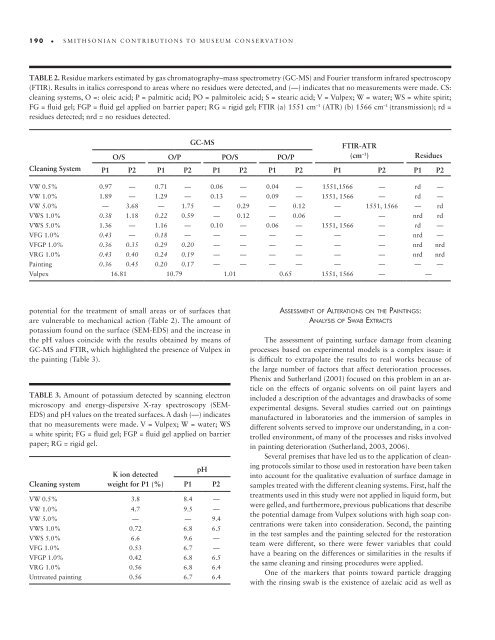You also want an ePaper? Increase the reach of your titles
YUMPU automatically turns print PDFs into web optimized ePapers that Google loves.
190 • smithsonian contributions to museum conservation<br />
Table 2. Residue markers estimated by gas chromatography–mass spectrometry (GC- MS) and Fourier transform infrared spectroscopy<br />
(FTIR). Results in italics correspond to areas where no residues were detected, and (—) indicates that no measurements were made. CS:<br />
cleaning systems, O =: oleic acid; P = palmitic acid; PO = palmitoleic acid; S = stearic acid; V = Vulpex; W = water; WS = white spirit;<br />
FG = fluid gel; FGP = fluid gel applied on barrier paper; RG = rigid gel; FTIR (a) 1551 cm –1 (ATR) (b) 1566 cm –1 (transmission); rd =<br />
residues detected; nrd = no residues detected.<br />
<strong>Cleaning</strong> System<br />
GC- MS<br />
O/S O/P PO/S PO/P<br />
FTIR- ATR<br />
(cm –1 )<br />
Residues<br />
P1 P2 P1 P2 P1 P2 P1 P2 P1 P2 P1 P2<br />
VW 0.5% 0.97 — 0.71 — 0.06 — 0.04 — 1551,1566 — rd —<br />
VW 1.0% 1.89 — 1.29 — 0.13 — 0.09 — 1551, 1566 — rd —<br />
VW 5.0% — 3.68 — 1.75 — 0.29 — 0.12 — 1551, 1566 — rd<br />
VWS 1.0% 0.38 1.18 0.22 0.59 — 0.12 — 0.06 — — nrd rd<br />
VWS 5.0% 1.36 — 1.16 — 0.10 — 0.06 — 1551, 1566 — rd —<br />
VFG 1.0% 0.43 — 0.18 — — — — — — — nrd —<br />
VFGP 1.0% 0.36 0.35 0.29 0.20 — — — — — — nrd nrd<br />
VRG 1.0% 0.43 0.40 0.24 0.19 — — — — — — nrd nrd<br />
Painting 0.36 0.45 0.20 0.17 — — — — — — — —<br />
Vulpex 16.81 10.79 1.01 0.65 1551, 1566 — —<br />
potential for <strong>the</strong> treatment <strong>of</strong> small areas or <strong>of</strong> surfaces that<br />
are vulnerable to mechanical action (Table 2). The amount <strong>of</strong><br />
potassium found on <strong>the</strong> surface (SEM- EDS) and <strong>the</strong> increase in<br />
<strong>the</strong> pH values coincide with <strong>the</strong> results obtained by means <strong>of</strong><br />
GC- MS and FTIR, which highlighted <strong>the</strong> presence <strong>of</strong> Vulpex in<br />
<strong>the</strong> painting (Table 3).<br />
Table 3. Amount <strong>of</strong> potassium detected by scanning electron<br />
microscopy and energy- dispersive X- ray spectroscopy (SEM-<br />
EDS) and pH values on <strong>the</strong> treated surfaces. A dash (—) indicates<br />
that no measurements were made. V = Vulpex; W = water; WS<br />
= white spirit; FG = fluid gel; FGP = fluid gel applied on barrier<br />
paper; RG = rigid gel.<br />
<strong>Cleaning</strong> system<br />
K ion detected<br />
weight for P1 (%)<br />
P1<br />
pH<br />
VW 0.5% 3.8 8.4 —<br />
VW 1.0% 4.7 9.5 —<br />
VW 5.0% — — 9.4<br />
VWS 1.0% 0.72 6.8 6.5<br />
VWS 5.0% 6.6 9.6 —<br />
VFG 1.0% 0.53 6.7 —<br />
VFGP 1.0% 0.42 6.8 6.5<br />
VRG 1.0% 0.56 6.8 6.4<br />
Untreated painting 0.56 6.7 6.4<br />
P2<br />
Assessment <strong>of</strong> Alterations on <strong>the</strong> <strong>Paintings</strong>:<br />
Analysis <strong>of</strong> Swab Extracts<br />
The assessment <strong>of</strong> painting surface damage from cleaning<br />
processes based on experimental models is a complex issue: it<br />
is difficult to extrapolate <strong>the</strong> results to real works because <strong>of</strong><br />
<strong>the</strong> large number <strong>of</strong> factors that affect deterioration processes.<br />
Phenix and Su<strong>the</strong>rland (2001) focused on this problem in an article<br />
on <strong>the</strong> effects <strong>of</strong> organic solvents on oil paint layers and<br />
included a description <strong>of</strong> <strong>the</strong> advantages and drawbacks <strong>of</strong> some<br />
experimental designs. Several studies carried out on paintings<br />
manufactured in laboratories and <strong>the</strong> immersion <strong>of</strong> samples in<br />
different solvents served to improve our understanding, in a controlled<br />
environment, <strong>of</strong> many <strong>of</strong> <strong>the</strong> processes and risks involved<br />
in painting deterioration (Su<strong>the</strong>rland, 2003, 2006).<br />
Several premises that have led us to <strong>the</strong> application <strong>of</strong> cleaning<br />
protocols similar to those used in restoration have been taken<br />
<strong>into</strong> account for <strong>the</strong> qualitative evaluation <strong>of</strong> surface damage in<br />
samples treated with <strong>the</strong> different cleaning systems. First, half <strong>the</strong><br />
treatments used in this study were not applied in liquid form, but<br />
were gelled, and fur<strong>the</strong>rmore, previous publications that describe<br />
<strong>the</strong> potential damage from Vulpex solutions with high soap concentrations<br />
were taken <strong>into</strong> consideration. Second, <strong>the</strong> painting<br />
in <strong>the</strong> test samples and <strong>the</strong> painting selected for <strong>the</strong> restoration<br />
team were different, so <strong>the</strong>re were fewer variables that could<br />
have a bearing on <strong>the</strong> differences or similarities in <strong>the</strong> results if<br />
<strong>the</strong> same cleaning and rinsing procedures were applied.<br />
One <strong>of</strong> <strong>the</strong> markers that points toward particle dragging<br />
with <strong>the</strong> rinsing swab is <strong>the</strong> existence <strong>of</strong> azelaic acid as well as
















